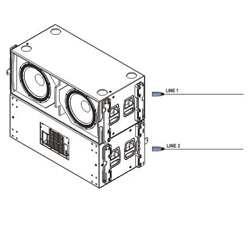This is the second in a multi-part series. Additional segments are available here.
Previously we examined the basics of cardioid subwoofer systems. This example continues that series.
Example 1. “Scaled down measurements: one cabinet in front and one cabinet behind”
Before trying to do these adjustments for the first time in a real- life situation, where one may not always have enough time and where conditions are far from ideal, scaled down measurements can be handy to get some practice with the procedure.
We’ll assume that you already know how to take transfer function measurements with the measurement system you are using, and that the equipment used is adequate.
As is the case with transfer function analysis, the reference signal needs to be synchronized to the measured subwoofer signal before a meaningful frequency response can be obtained. The coherence curve will normally be good enough unless there are strong reflections, excessive reverberation, widely differing levels for reference and measurement channels, hardware or software issues or if we forgot to synchronize the reference to the measurement signal.
Let’s now run some scaled down measurements of 18” subwoofers.
Subwoofer cut-off frequencies are:
HPF LR24dB/Oct, 30Hz
LPF LR24dB/Oct, 85Hz
We’ll use two 4” speakers to get some practice with the phase adjustment procedure. For our 4” to behave acoustically like our real, full scale systems, we will need to scale the crossover frequencies up.
To do that we’ll multiply the real system cut-off frequencies by the ratio of the real system to our scaled down box, i.e., we will multiply the cut-off frequencies by 18”/4” = 4.5
Therefore the cut-off frequencies for the scaled down measurements, which will be entered in the processor for the 4” system, will be as follows:
Cut-off frequencies for the scaled down subwoofer system are:
HPF LR24dB/Oct, 30Hz x 4.5 = 135Hz
LPF LR24dB/Oct, 85Hz x 4.5 = 382Hz
In this example we’ll use two subwoofers, one in front of the other.















